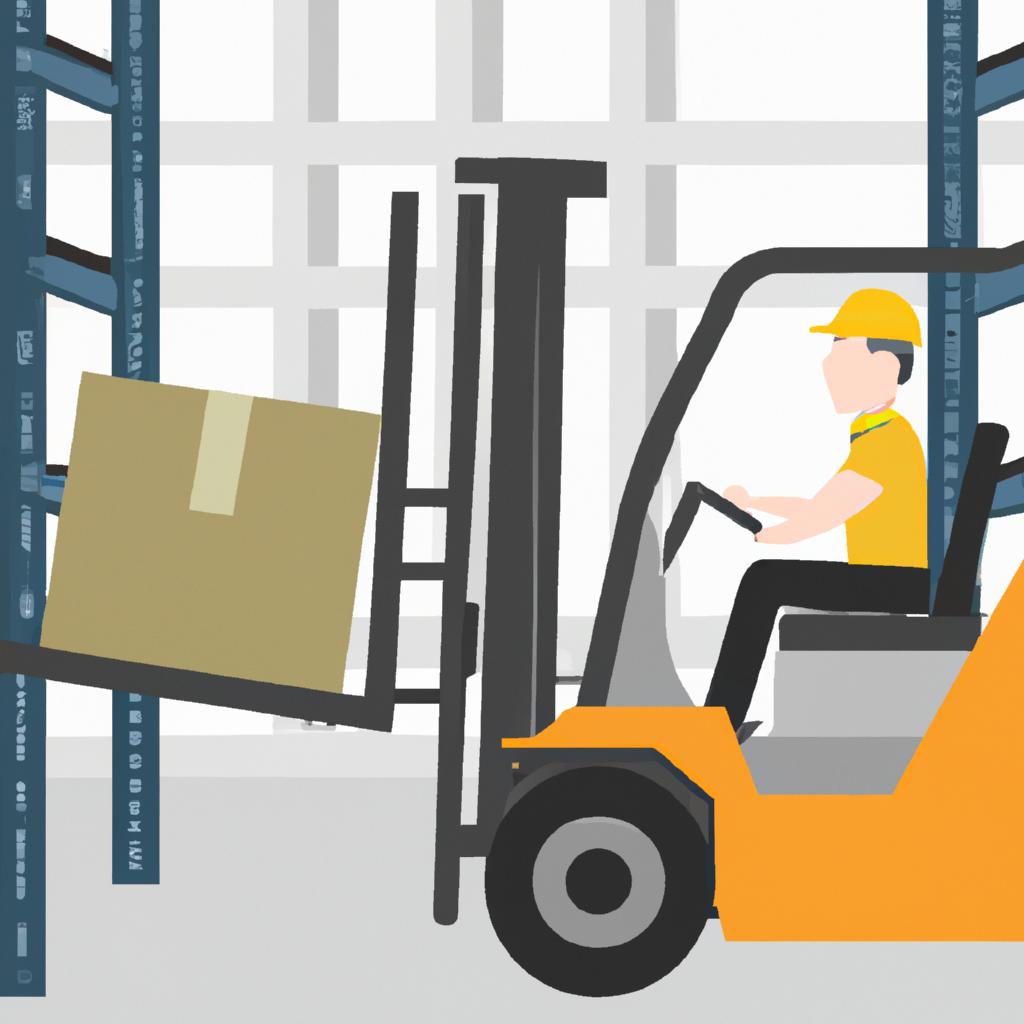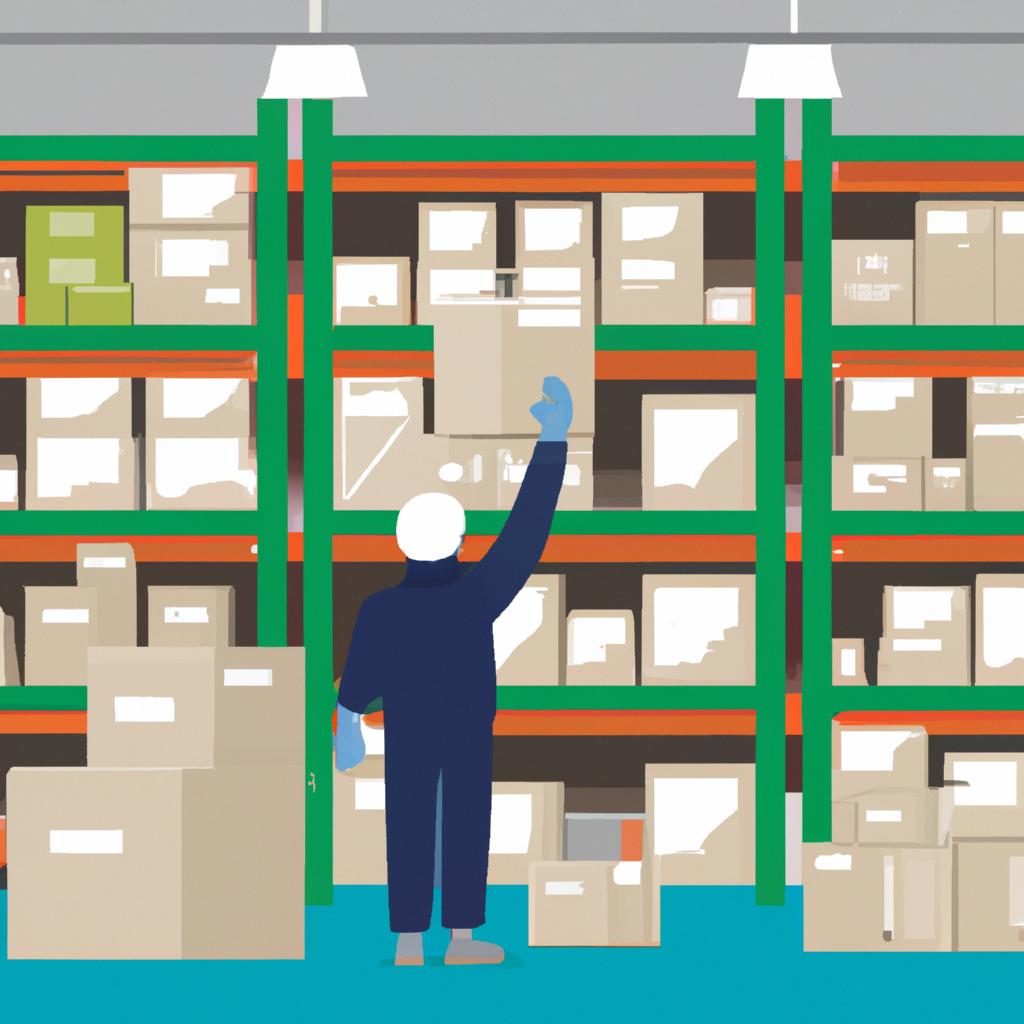Shipping & Transportation in Transportation and Logistics: Warehouse Operations


Shipping and transportation play a pivotal role in the efficient operations of warehouses within the broader field of transportation and logistics. The movement of goods from suppliers to customers requires careful coordination and strategic planning, ensuring that products reach their destinations in a timely manner. For instance, consider a hypothetical scenario where an e-commerce company receives an order for multiple items placed by a customer located in another country. In this case, effective shipping and transportation processes are crucial to ensure that all items are picked, packed, and delivered accurately while minimizing delays or disruptions.
Within warehouse operations, shipping entails various activities such as order processing, packing, labeling, loading onto vehicles or containers, and organizing transport routes. To streamline these processes effectively, advanced technologies like barcode scanning systems and inventory management software have become essential tools. By utilizing these technological advancements, companies can enhance accuracy levels during order fulfillment and reduce errors caused by manual handling. Additionally, automated sorting systems facilitate efficient packaging and labeling procedures while optimizing space utilization within the warehouse premises.
Transportation plays a vital role in ensuring smooth supply chain operations by connecting warehouses with distribution centers or directly delivering products to end-consumers.
Types of Shipping Methods
Types of Shipping Methods
Imagine a company that manufactures and distributes electronic devices worldwide. To ensure timely delivery and customer satisfaction, the company must carefully consider its shipping methods. There are several types of shipping methods available, each with their own advantages and limitations.
Firstly, let’s consider air freight. This method involves transporting goods by aircraft, offering speed and efficiency in delivery. For instance, if our hypothetical electronics company needs to ship urgent orders to customers located overseas, air freight would be the most suitable option. Not only does it reduce transit time significantly, but it also allows for greater flexibility in terms of scheduling.
On the other hand, there is ocean freight which involves the transportation of goods via cargo ships. Although it may take longer compared to air freight, this method offers considerable cost savings when shipping large quantities or bulky items. For example, our electronics company might choose ocean freight when delivering bulk orders to retailers across different regions as it provides an economical solution while maintaining product availability.
Alternatively, road transport is another commonly used shipping method. It entails moving goods using trucks or vans over land routes. Road transport is particularly advantageous for domestic shipments due to its accessibility and extensive network coverage. In situations where time sensitivity is not paramount and cost-effectiveness is prioritized, this method can be a reliable choice.
To summarize:
- Air Freight: Fast and flexible; ideal for urgent international deliveries.
- Ocean Freight: Economical for large quantities or bulky items; suited for global distribution.
- Road Transport: Reliable for domestic shipments; accessible and cost-effective.
In addition to these three main shipping methods, companies may also utilize rail transport for long-distance ground shipment or intermodal transport combining multiple modes of transportation such as trucking and railway services.
The importance of efficient transportation in logistics cannot be overstated. Ensuring that products reach customers promptly plays a crucial role in maintaining customer satisfaction and loyalty. Therefore, understanding the various shipping methods available enables companies to make informed decisions based on the nature of their products, delivery requirements, and budget constraints. In the subsequent section, we will delve further into the significance of efficient transportation in logistics operations.
Importance of Efficient Transportation in Logistics
Title: Shipping & Transportation in Transportation and Logistics: Warehouse Operations
Previous section H2: Types of Shipping Methods
Next section H2: Importance of Efficient Transportation in Logistics
Transitioning from the previous section discussing various types of shipping methods, it is crucial to understand the importance of efficient transportation within logistics. This section will highlight the significance of streamlined transportation processes by exploring a hypothetical scenario that showcases its impact on warehouse operations.
Consider a multinational retail company with multiple warehouses located across different regions. One particular warehouse receives shipments from suppliers worldwide and distributes products to various stores. Inefficient transportation practices can lead to delays, increased costs, and potential disruptions throughout the entire supply chain.
To comprehend the gravity of efficient transportation, let us examine some key points:
- Timely Deliveries: Efficient transportation ensures that goods are delivered promptly to their destinations. Delays in transit not only hinder customer satisfaction but also result in lost sales opportunities.
- Cost Optimization: Streamlined transport systems lead to cost savings as they minimize fuel consumption, reduce maintenance expenses, and optimize route planning.
- Improved Inventory Management: Effective transportation allows for better inventory control by facilitating accurate demand forecasting and reducing stockouts or overstocks.
- Sustainability Initiatives: Environmentally-conscious shipping methods contribute towards sustainable practices, reducing carbon emissions and minimizing ecological impacts.
To illustrate these concepts further, consider the table below which compares two scenarios – one with inefficient transportation practices (Scenario A) and another with optimized transport processes (Scenario B):
| Scenario A | Scenario B | |
|---|---|---|
| Delivery Time | Lengthy delays | On-time deliveries |
| Costs | Higher expenditures | Reduced expenses |
| Inventory Availability | Frequent stockouts | Optimal stock levels |
| Environmental Footprint | Increased emissions | Eco-friendly measures |
Understanding the impact of efficient transportation on warehouse operations is crucial for effective logistics management. This awareness prompts businesses to prioritize investments in improving transportation practices, ultimately benefiting their overall supply chain performance.
Transitioning into the subsequent section on the role of technology in shipping and transportation, it is evident that advancements in technological solutions play a vital part in enhancing efficiency throughout the entire logistics process. The integration of innovative tools and systems enables companies to streamline operations further, ensuring seamless connectivity between warehouses, carriers, and customers alike.
Role of Technology in Shipping and Transportation
Importance of Efficient Transportation in Logistics
Efficient transportation plays a crucial role in the smooth and effective functioning of logistics operations. A prime example illustrating this importance is the case of Company X, an international retailer that relied heavily on timely deliveries to meet customer demands. The company had experienced significant delays caused by inefficient transportation processes, resulting in dissatisfied customers and increased costs due to missed delivery deadlines.
To emphasize the significance further, consider these key points:
- Timely Deliveries: Effective transportation ensures goods are delivered according to schedule, meeting customer expectations and reducing any potential disruptions or delays.
- Cost Reduction: Efficient transport systems help minimize operational costs associated with unnecessary fuel consumption, vehicle maintenance, and labor expenses.
- Inventory Management: Streamlined transportation allows for better inventory management by optimizing shipment times and reducing excessive stock levels.
- Customer Satisfaction: Prompt and reliable deliveries improve customer satisfaction levels as they receive their orders promptly, leading to repeat business and positive word-of-mouth referrals.
Table 1 below summarizes the benefits of efficient transportation in logistics:
| Benefits | Description |
|---|---|
| Timely Deliveries | Ensures goods reach customers on time |
| Cost Reduction | Minimizes operational expenses |
| Improved Inventory Management | Optimizes shipment times and reduces stock levels |
| Enhanced Customer Satisfaction | Increases customer happiness through prompt deliveries |
In conclusion, efficient transportation is critical for successful logistics operations. It not only facilitates timely deliveries but also helps reduce costs, optimize inventory management, and enhance overall customer satisfaction. With these factors in mind, it becomes evident that companies must prioritize improving their transportation strategies to stay competitive in today’s dynamic market.
Transitioning into the next section about "Challenges Faced in Shipping and Transportation," it is essential to address the obstacles that can hinder efficient transport systems. By recognizing these challenges, companies can develop effective solutions to overcome them seamlessly.
Challenges Faced in Shipping and Transportation
Role of Technology in Shipping and Transportation
Technology plays a pivotal role in the efficient functioning of shipping and transportation operations. With advancements in technology, various tools and systems have been developed to streamline processes and enhance overall productivity. One example that highlights the impact of technology is the implementation of automated tracking systems.
Automated tracking systems utilize barcode scanning or GPS technology to monitor shipments throughout their journey. This allows logistics companies to have real-time visibility into the location and status of goods. For instance, Company X implemented an automated tracking system for its warehouse operations. By doing so, they were able to reduce time spent searching for items within the warehouse by 50%, leading to improved efficiency and faster order fulfillment.
In addition to automated tracking systems, there are several other technological advancements that have revolutionized shipping and transportation:
- Route optimization software: This tool helps determine the most efficient routes based on factors such as traffic conditions, fuel consumption, and delivery schedules. By optimizing routes, companies can minimize travel time, reduce costs, and improve customer satisfaction.
- Warehouse management systems (WMS): WMS enables organizations to effectively manage inventory levels, track stock movements, and optimize storage space utilization. It also facilitates seamless coordination between different departments involved in warehouse operations.
- Electronic data interchange (EDI): EDI allows for the electronic exchange of documents between supply chain partners. This eliminates manual paperwork, reduces errors, speeds up communication, and enhances overall collaboration.
- Robotics and automation: The use of robots in warehouses has significantly transformed material handling processes. Robots can perform tasks such as picking, packing, sorting, and stacking with speed and precision.
Table: Benefits of Technological Advancements in Shipping & Transportation
| Benefit | Description |
|---|---|
| Increased efficiency | Automation reduces human error rates while streamlining processes |
| Improved accuracy | Advanced technologies ensure accurate tracking, inventory management |
| Enhanced customer experience | Real-time tracking, faster delivery times, and improved communication lead to satisfied customers |
| Cost savings | Optimization tools help reduce fuel consumption, minimize travel distances |
In conclusion, technology has become an integral part of shipping and transportation operations. The implementation of automated tracking systems, route optimization software, warehouse management systems, electronic data interchange, and robotics has significantly improved efficiency and accuracy in these sectors. These advancements not only benefit organizations but also enhance the overall customer experience by providing real-time information and faster delivery times. In the subsequent section about "Benefits of Outsourcing Shipping Services," we will explore how outsourcing can further optimize shipping processes.
Next Section H2: Benefits of Outsourcing Shipping Services
Benefits of Outsourcing Shipping Services
Challenges Faced in Shipping and Transportation
One real-life example that highlights the challenges faced in shipping and transportation is the case of a global e-commerce company. This company relies heavily on timely delivery to maintain customer satisfaction. However, due to various issues in their shipping and transportation operations, they experienced frequent delays and disruptions, leading to dissatisfied customers and increased costs.
There are several key challenges that companies often encounter when it comes to shipping and transportation:
-
Supply chain complexity: The movement of goods from warehouses to distribution centers, and finally to customers involves multiple stakeholders and processes. Coordinating these activities can be complex, especially when dealing with international shipments or managing high volumes of orders.
-
Infrastructure limitations: Inadequate infrastructure, such as outdated ports or congested roads, can hinder the smooth flow of goods. Delays caused by bottlenecks at critical points along the supply chain can result in missed delivery deadlines.
-
Regulatory compliance: Compliance with regulations related to customs documentation, safety standards, and environmental requirements adds an additional layer of complexity to shipping and transportation operations. Failure to comply with these regulations can lead to penalties or even legal consequences.
-
Risk management: Shipping and transportation involve inherent risks such as theft, damage, loss, or natural disasters. Implementing effective risk management strategies is crucial for mitigating these risks and ensuring the safe arrival of goods.
To illustrate the emotional impact of these challenges on businesses and consumers alike:
- Increased costs: Companies may experience financial strain due to extra expenses incurred from delayed deliveries or unexpected disruptions.
- Customer dissatisfaction: Late deliveries or damaged goods can lead to frustrated customers who may switch to competitors.
- Environmental concerns: Inefficient transportation practices contribute significantly to carbon emissions and pollution levels.
- Lost opportunities: Delays in transporting goods can result in missed sales opportunities or production delays.
| Challenges | Impact |
|---|---|
| Supply chain complexity | Increased operational costs |
| Infrastructure limitations | Delays in delivery schedules |
| Regulatory compliance | Legal and financial penalties |
| Risk management | Loss of goods or assets |
By addressing these challenges, companies can enhance their shipping and transportation operations to improve efficiency, reduce costs, and ultimately provide better service to customers. In the next section, we will explore the impact of sustainable transportation practices on logistics.
Impact of Sustainable Transportation in Logistics
Impact of Sustainable Transportation in Logistics
Impact of Sustainable Transportation in Logistics
One example that showcases the impact of sustainable transportation in logistics is the case study of Company X. This company, specializing in warehouse operations and shipping services, decided to implement sustainable transportation practices as part of their overall commitment to reduce their carbon footprint. By switching from traditional diesel-fueled trucks to electric vehicles for local deliveries, they were able to significantly decrease their greenhouse gas emissions while still maintaining efficient delivery schedules.
Sustainable transportation practices offer several benefits within the field of logistics:
- Environmental Impact: Implementing sustainable transportation methods helps reduce air pollution by minimizing harmful emissions released into the atmosphere. This contributes to cleaner air quality and a healthier environment for both employees and surrounding communities.
- Cost Savings: While there may be initial investments required to adopt sustainable transportation technologies, companies can experience long-term cost savings through reduced fuel consumption and maintenance costs associated with more eco-friendly vehicles. Additionally, some governments provide incentives or tax breaks for organizations adopting sustainable practices.
- Reputation Enhancement: Incorporating sustainability initiatives into transportation and logistics operations can enhance a company’s reputation among customers, stakeholders, and potential business partners who value environmentally responsible practices. It demonstrates a commitment towards corporate social responsibility (CSR) and attracts socially conscious consumers.
- Compliance with Regulations: Many countries have implemented regulations aimed at reducing carbon emissions and promoting sustainable transportation practices. Adhering to these regulations ensures legal compliance for businesses operating within such jurisdictions.
To further illustrate the positive impacts of sustainable transportation on logistical operations, consider the following table:
| Traditional Transportation Methods | Sustainable Transportation Methods | |
|---|---|---|
| Emissions | High levels of CO2 emissions | Reduced emissions |
| Costs | Higher fuel consumption | Lower fuel costs |
| Reputation | May not attract eco-conscious clients | Enhanced CSR image |
As seen above, implementing sustainable transportation methods leads to significant improvements across various aspects of logistics operations.
In conclusion, the integration of sustainable transportation practices in logistics has a substantial impact on warehouse operations and shipping services. By adopting eco-friendly vehicles, companies can reduce their environmental footprint, achieve cost savings, enhance their reputation, and ensure compliance with regulations. The case study of Company X exemplifies how such initiatives can be successfully implemented within the industry. Ultimately, embracing sustainable transportation is not only beneficial for individual businesses but also contributes to a greener and more sustainable future for all.






